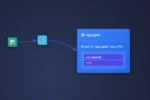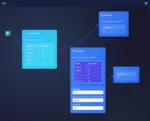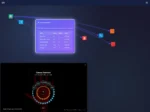
by tyler garrett | Jun 28, 2025 | Data Visual
In today’s era of explosive data growth, understanding the clues hidden within immense volumes of information has become crucial. Anomalies—those unexpected patterns or outliers—concealed within big datasets not only distort insights but also create critical challenges for businesses. That’s where anomaly detection visualization steps into the spotlight. Employing powerful data visualization techniques coupled with advanced anomaly detection algorithms provides organizations the ability to identify, analyze, and swiftly respond to irregularities. Let’s explore how this technology can transform the way decision-makers harness big data, turning obscure data points into actionable intelligence and driving innovative strategic decisions.
Understanding Anomaly Detection Visualization
Anomaly detection visualization combines algorithmic data analysis with easy-to-grasp visual representation. Think of anomalies as needle-in-a-haystack problems: large, complex datasets inevitably contain irregularities that range from harmless data errors to significant security threats and business risks. Quickly spotting these anomalies in raw numbers alone can be arduous or impossible. Through intuitive graphical representations such as scatter plots, heatmaps, and isotype charts—the modern implementation of pictogram visualization—organizations are empowered to detect and interpret anomalies efficiently.
Visualization transforms abstract numerical outputs of analytics algorithms, producing immediate clarity around the location, frequency, and significance of anomalies. Advanced analytic techniques such as machine learning (ML), statistical modeling, and artificial intelligence (AI)-based approaches become far more potent when paired with impactful visual storytelling. This crucial intersection of data science and visual analytics equips managers and stakeholders to identify issues early, enabling strategic interventions before anomalies escalate into critical operational or financial impacts.
Moreover, visualization of anomaly detection supports cross-departmental communications. It enables business teams and technical practitioners alike to collaborate effectively—discovering areas to fine-tune data validation methods through solutions like Schema Registry integration for pipeline data validation, resulting in a unified, data-driven decision-making culture.
Strategic Application Areas for Anomaly Detection Visualization
Anomaly detection visualization is broadly relevant across industries, including finance, healthcare, construction, non-profits, and software. For instance, in the construction sector, anomaly detection can monitor sensor data or workflow anomalies, especially when integrated smoothly with modern platforms such as Procore API consulting services. This allows stakeholders to notice deviations in project timelines, safety indicators, or quality standards that might otherwise pass unnoticed until expensive rectifications become necessary.
In finance, anomaly detection visualization systems can reveal fraudulent transactions through streamlined visual dashboards, rapidly highlighting suspicious behaviors. Non-profits, often facing distinct resource constraints but urgent data needs, significantly benefit from relevant business intelligence solutions tailored for non-profits, helping identify unusual donor or community engagement patterns early and maintain operational transparency.
Healthcare organizations visualize anomalies in patient monitoring data, quickly identifying health risks that require immediate action. Similarly, supply chain companies rely on anomaly detection visualization to spot inventory irregularities or delivery issues. Leveraging these strategic visualizations decision-makers can actively maintain operational efficiency, increase cost-effectiveness, and ensure that anomaly resolution processes remain data-driven and consistent.
Essential Techniques to Visualize Anomalies
To fully harness anomaly detection visualization, businesses need to wisely select appropriate techniques and tools according to their specific analytical needs. Common visualization types include scatter plots, which visually expose data outliers through intuitive clustering. Time-series visualizations effectively highlight deviations in periodic trends over minutes, hours, days, or months. Heatmaps-based visual analytics are immensely valuable when monitoring high-dimensional datasets, offering immediate visual attention points that guide effective decision-making.
For parallel processing involving massive datasets, implementing design patterns such as fan-out/fan-in patterns for parallel data processing ensures optimal computing efficiency. In visualization, translating these complex computations into clearly understandable outputs provides added analytical value, particularly in large-scale data environments.
Specialized pictogram visualizations such as isotype charts enable businesses to quickly convey anomaly-driven insight with visually appealing imagery, boosting understanding across diverse stakeholder groups. Organizations that adopt visual storytelling effectively streamline anomaly identification, analysis, and communication, enhancing agility around data-driven actions and response.
Boosting Detection Speed with Computational Storage and Distributed Processing
As datasets scale, traditional data analytics methods can become progressively less responsive. Fortunately, innovative computational solutions allow organizations to maintain responsiveness at enterprise scale, catering specifically to demanding anomaly detection needs. Approaches such as computational storage—which processes analytics directly at the storage layer—are an emerging strategy businesses can leverage for increased analytics efficiency. As discussed in our article about computational storage and processing at the storage layer, this method practically eliminates latency associated with data transit.
Additionally, distributed systems’ shuffle operations optimization, as covered in our guide on
optimizing shuffle operations in distributed data processing, further enhance response times during anomaly detection tasks. By addressing bottlenecks inherent in big data clusters, optimized infrastructure ensures that anomaly analytics become practically real-time, dramatically shortening detection-response windows.
Sophisticated algorithms and computational practices such as ML-driven visual anomaly detection, coupled with robust visualization tools, consolidate these efficiencies. Thus, infrastructure investments and strategic computational decisions directly translate into faster anomaly identification, improved responsiveness, and increased organizational competitive advantage.
Building a Culture of Data Confidence & Actionable Insights
Anomaly detection visualization not only enhances analysis capabilities—it’s a strategic investment in fostering organizational data confidence. When decision-makers quickly interpret anomalies thanks to clear visualization, timely interventions become second nature—effectively embedding analytics culture deep within the enterprise. Because visualization is approachable and intuitive, businesses rapidly elevate their analytical preparedness and thus significantly reduce the business impact of anomalies.
Moreover, empowering diverse teams across the business with these visual insights creates openness around analytical findings. Visualization clarity removes barriers between technical experts and strategic managers, resulting in engaged collaboration and informed strategic decisions. As anomalies are rapidly understood and addressed, a shared commitment to accuracy, quality, and innovation thrives. Building processes around visual anomaly identification allows businesses to confidently guide strategy, innovate readily, and maximize the value of big data investments.
Enterprise transformation leveraging anomaly detection visualization creates robust preparedness, unlocking deep analytics-driven innovation and decision-making potential. When organizations culturally embrace visualization-driven insights, strategic progress and agility rapidly become business as usual.
Conclusion: Visualizing Anomalies, Unlocking Value
In the modern era of rapidly expanding datasets, anomaly detection visualization stands at the forefront of advanced analytics practices. Leveraging clear graphical representations, real-time analytics infrastructure, and powerful computational strategies, businesses can instantly decode outlier patterns—unlocking valuable opportunities previously hidden within big data complexities. With understanding comes actionability, empowering strategic responses driven by confident visual interpretation.
From adopting cutting-edge parallel processing and computational storage strategies to harnessing impactful visualization technologies, anomaly detection visualization helps businesses maintain data clarity amid overwhelming datasets. Prepare your organization for future analytics success by investing strategically in these capabilities—bringing transparency, actionability, and innovation to the forefront of your decision-making frameworks.
Thank you for your support, follow DEV3LOPCOM, LLC on LinkedIn and YouTube.

by tyler garrett | Jun 28, 2025 | Data Visual
Imagine managing a physical manufacturing plant and simultaneously interacting with its exact digital replica from anywhere in the world—predicting outcomes, enhancing efficiencies, and optimizing performance in real-time. This isn’t science fiction; it’s Digital Twin Visualization—an innovative intersection of Internet of Things (IoT), advanced analytics, and dynamic visualization technologies. With industries striving for operational excellence and competitive advantages, digital twin adoption is rapidly transforming asset management capabilities, propelling companies into a smarter, data-driven future. By creating virtual mirrors of physical assets, organizations gain unprecedented insights—fueled by data patterns, visual transparency, and predictive sophistication. Let’s unfold how digital twin visualization is changing asset management, increasing return on investment (ROI), and empowering strategic decision-making.
What Exactly Is a Digital Twin?
A digital twin is a comprehensive virtual representation or “mirror-image” of a real-world physical object, system, or process. It bridges the digital and physical worlds by using sensors, IoT devices, and real-time data analytics, creating an interactive model that accurately simulates the behavior, performance, and characteristics of its physical counterpart. Think of digital twins as living models continuously fed with sensor data to maintain synchronicity with their real-world counterparts, resulting in an ever-evolving snapshot of operations. From aerospace and automotive to smart cities and manufacturing, companies are leveraging digital twins to gain actionable insights, proactively mitigate risks, and boost asset optimization.
Built on platforms like Microsoft Azure, businesses readily harness cloud computing platforms such as our reliable and scalable Azure consulting services to effectively create integrated digital twin solutions. By centralizing data visualization and analytics in the cloud, organizations ensure broad accessibility, real-time interaction, and collaborative efficiency among stakeholders scattered across diverse locations. This precision in visual representation drives not only informed decision-making but also fuels operational agility, an increasingly crucial differentiator in today’s competitive market.
How Visualization Amplifies the Impact of Digital Twins
Visualization is the key to unlocking the true potential of digital twins. While capturing vast arrays of data points from multiple sensor inputs is foundational, the visual presentation allows executives, engineers, and analysts to grasp complex interactions quickly and meaningfully. High-quality visualizations eliminate confusion, enabling teams to rapidly detect anomalies, understand cause-and-effect relationships, and anticipate potential issues long before they happen, ultimately transforming data complexity into actionable clarity. Techniques like progressive disclosure in complex visualization interfaces simplify intricate data interactions, letting decision-makers incrementally explore information without cognitive overload.
With visually rich dashboards powered by advanced analytics, organizations can easily explore asset performance indicators, identify patterns, and drive decisions about maintenance schedules, operational adjustments, and resource allocation. Imagine a facility manager observing a virtual reset of critical machinery just seconds after a sensor registers an impending malfunction, addressing problems proactively rather than reactively, significantly minimizing downtime and boosting overall operational efficiency.
Innovations like augmented reality (AR) and virtual reality (VR) elevate digital twin visualization even further. Combining digital twins with immersive AR/VR visualizations allows users to virtually “physically” interact with assets, significantly enhancing comprehension, identifying inefficiencies, and further streamlining operations. Such advanced visualization techniques enable faster interpretation and smarter operational decisions.
Powering Predictive Analytics through Digital Twin Visualization
One of the strongest advantages of adopting digital twin technology lies in predictive analytics capabilities, markedly reshaping an organization’s approach to asset monitoring and management. By continuously analyzing real-time performance data within visual twin interfaces, predictive models proactively signal potential issues, thereby minimizing risks and reducing downtime. Digital twins allow stakeholders to transform raw IoT-generated data into meaningful insights; this data mining capability reveals hidden patterns, strengthens predictive modeling, and significantly reduces uncertainty in production operations.
For instance, predictive analytics can forecast equipment failure, enabling preventive actions rather than waiting for expensive repairs after the fact. Advanced visualizations clearly represent predictive model results, allowing stakeholders—especially those less versed in detailed predictive analytics—to make sharply focused decisions around maintenance, performance monitoring, or asset replacement schedules. Such integrations of predictive analytics and digital twin visualization not only prevent costly downtime but also ensure that resources are used optimally, curbing unnecessary expenses and boosting return on capital investments.
Quality Control Improvements through Digital Twins
Digital twin visualization offers significant improvements in industries requiring stringent quality control. Quality assurance teams employing digital twins can compare real-time sensor readings from physical assets with projected ideal behavior, identifying deviations instantly and expediting issue resolution. Further steps toward quality optimization include effective integration with sophisticated tools, such as employing data fingerprinting to spot data redundancy and ensure accurate asset records, promoting enhanced precision throughout the operational landscape.
For example, in manufacturing settings, digital twins stream sensor-driven insights regarding machinery performance directly into visual interfaces, providing immediate visibility into regulatory compliance or operational anomalies. As visualization emphasizes deviations from established norms or performance benchmarks, operations teams can act swiftly and decisively, reducing waste, mitigating defects, and ensuring products meet rigorous quality standards. This combination of precise digital visualization paired with continuously streaming operational data significantly elevates quality control processes, magnifies efficiency, and ultimately delivers customer satisfaction and brand value.
Overcoming Challenges with Digital Twin Visualization
Although the benefits of digital twin visualization are compelling, organizations must acknowledge and overcome certain implementation challenges to maximize value effectively. Understanding common pitfalls such as data processing anti-patterns allows businesses to proactively establish robust foundational data strategies that uphold optimal visualization performance and successful digital twin integration. Data governance, cybersecurity, and ensuring scalability are crucial factors in achieving sustainable and beneficial digital twin deployments.
Another notable challenge organizations encounter is the potential complexity digital twins and their visualization interfaces may present to non-technical decision-makers. To address this, intensive focus on simplified user experiences—leveraging techniques like KPI visualization best-practices outlined in our Tableau KPI charts guide—ensures digital twins can be effectively utilized across varying decision-making levels, inspiring confident, data-driven strategic moves.
By investing in the right partnerships, educational initiatives, and strategic alignment, companies can circumvent challenges—and reap the robust benefits digital twin visualization provides. This sustained investment drives operational efficiencies, significantly increases asset longevity, and fuels innovation-driven competitiveness for the future.
Shaping Real-Time Decision-Making with Digital Twins
Leveraging exceptional visualization strategies alongside digital twin technology accelerates real-time decision-making capabilities and organizational responsiveness. According to proven methodologies explored in our real-time analytics architecture patterns, digital twins enable near-instantaneous asset performance monitoring, ensuring key stakeholders remain aligned and informed about dynamic operations, regardless of geographical distance.
Harnessing real-time visualization updates empowers individuals across an organization to detect and respond promptly to operational deviations or opportunities, translating into significantly faster decision cycles and invaluable agility across competitive industries. Digital twin visualization acts as a powerful strategic instrument, fueling cohesive responses to market shifts and setting companies up to outperform competitors. In today’s accelerated landscape, where time is a critical factor influencing competitiveness and profitability, strategic real-time responses are paramount. Digital twin visualization is precisely the tactical advantage needed for success.
By integrating robust digital twin visual platforms and real-time analytics simultaneously, organizations equip themselves with state-of-the-art technology tools that embody advanced, data-driven leadership—delivering breakthrough results and enviable market positions.
Conclusion: Digital Twin Visualization is Your Strategic Future
The future belongs to organizations leveraging digital twins effectively and confidently, transforming complex data into precise visual strategies, predictive insights, and actionable real-time decisions. Investing in robust digital twin visualization tools, platforms, and expertise positions your business as a forward-looking leader, primed to respond proactively, make strategic agility possible, and significantly outperform competitors. Given its immense potential for groundbreaking operational impact, decision-makers must prioritize adopting digital twin visualization strategies to ensure a sustainable competitive edge.
If you’re ready to harness digital twin visualization’s transformative power, seek experienced guidance, scalable cloud integrations, and cutting-edge analytics solutions—it’s time to start your journey to the digital twin future.
Tags: Digital Twin Visualization, IoT, Predictive Analytics, Data Visualization, Real-Time Analytics, Asset Optimization
Thank you for your support, follow DEV3LOPCOM, LLC on LinkedIn and YouTube.

by tyler garrett | Jun 28, 2025 | Data Visual
In today’s rapidly transforming digital landscape, navigating regulatory compliance is no longer a matter of manual checklists and static reports. Businesses require dynamic, intuitive, and automated analytics solutions that not only streamline compliance efforts but also identify and mitigate risks proactively. Enter regulatory compliance dashboards—a sophisticated yet accessible blend of data engineering, actionable insights, and innovative risk assessment capabilities. Leveraging advanced data engineering consulting services can revolutionize the way your business approaches compliance. In this blog, we’ll demystify how technology-driven dashboards empower stakeholders with real-time, automated risk evaluations, ensuring more accurate, measurable, and agile compliance management.
Understanding the Importance of Regulatory Compliance Dashboards
In an environment increasingly governed by stringent regulations and rapidly changing industry standards, businesses need more than reactive methods to maintain compliance; they must adopt proactive strategies. Regulatory compliance dashboards play a key strategic role by pulling together large volumes of complex compliance data and translating it into meaningful, digestible insights. By employing strong data visualization techniques, these dashboards provide real-time overviews and actionable information that helps organizations quickly identify potential compliance threats or deviations.
Automating compliance assessments through these dashboards not only reduces the manpower traditionally required for manual reporting tasks but also significantly improves accuracy and accountability. Since data integrity is paramount in compliance, your business benefits immensely from timely error detection and corrected measures offered by automated monitoring. Enterprises that leverage dashboards for compliance tracking gain a distinct competitive advantage by efficiently focusing their strategic resources on growth rather than administrative oversight.
Moreover, stakeholders can customize dashboards to show critical KPIs aligned with their specific business objectives, compliance regulations, and risk management strategies. By effectively visualizing compliance risks, businesses can swiftly address potential issues, thus significantly reducing compliance costs, financial risks associated with regulatory infractions, and reputational damage.
The Role of Real-Time Data in Compliance and Risk Assessment
When it comes to compliance and risk management, timing matters. Businesses that rely on outdated data or periodic manual assessments expose their organization to considerable vulnerabilities. This is where the importance of streaming data and real-time analytics shines through. Incorporating technologies adept at handling large volumes of data quickly, such as outlined in our previous blog on handling streaming data at scale, becomes imperative to maintain regulatory adherence effectively.
Real-time compliance dashboards provide up-to-the-minute perspectives on your organization’s compliance status and relevant risks, empowering you to respond proactively, rather than reactively, to emerging issues. With instantaneous risk feedback, these dashboards allow your teams to implement mitigation actions before minor inefficiencies escalate into significant compliance breaches.
Also, leveraging advanced data processing techniques, such as those described in our post on processing window strategies for streaming analytics, becomes crucial in compliance scenarios. These analytic advancements enable organizations to pinpoint exactly when and where a compliance event or risk originated, thus enhancing transparency and clarity throughout regulatory processes and audits. As a result, real-time data transforms compliance strategies from static afterthoughts into live operational components that optimize organizational growth instead of hindering it.
Enhancing Efficiency with Automation and Risk Scoring
Automation within compliance dashboards isn’t merely about reducing manual effort. It’s about embedding systematic processes in identifying anomalies, predicting potential breaches, and assigning risk scores to proactively prioritize interventions. Automating compliance validation and risk scoring achieves scalability, accuracy, and transparency—key drivers of operational excellence. Companies can leverage advanced analytic frameworks, such as the techniques discussed in our article impact analysis automation for data pipeline changes, to ensure smooth incorporation of adjustments and enhancements in their dashboards.
With automated assessments, businesses benefit from consistent risk evaluation methodologies. Misalignment or subjectivity present in manual evaluations are significantly reduced, making risk assessments more dependable and transparent for regulatory stakeholders. Further, by employing predictive modeling and automated scoring metrics, your IT and compliance teams can shift from firefighting unexpected compliance issues to actively preventing potential breaches, saving considerable resources in the long term.
Utilizing intelligent pattern recognition and machine learning methodologies further enhances the risk scoring process. The integration of technologies such as those detailed in our article about machine learning pipeline design for production enables organizations not only to automate risk flagging but also refine predictions continually through the feedback loop generated by real-time assessments. This results in a self-optimizing compliance system, continually adapting and improving, reducing costs, and enhancing compliance accuracy across the enterprise.
Lightweight Models and Knowledge Distillation for Scalable Dashboards
To successfully manage compliance across large or distributed organizations, scalability and performance become critical elements. As dashboards grow, so too do the data processing requirements. Adopting streamlined approaches like those featured in our previous piece on knowledge distillation techniques for lightweight dashboard models becomes essential.
Through knowledge distillation, complex machine learning models and algorithms can be compressed into simplified yet effective analytics solutions for your compliance dashboards. Lightweight, distilled models improve dashboard responsiveness, reduce processing time, and enhance accessibility even on limited resources environments. Regardless if it’s executives accessing high-level compliance summaries or dedicated compliance teams drilling deeply into granular reports, a distilled analytical method ensures quick and intuitive access to critical insights and recommended actions.
The benefits extend beyond faster visualizations and analytics. Implementing lightweight dashboard models also reduces backend operational costs associated with computational resources, infrastructure, and energy, making regulatory compliance monitoring itself more sustainable and cost-effective. Strategic reliance on streamlined analytics solutions supports optimal decision-making capability at scale and enables rapid deployment or changes to reflect shifting regulatory requirements and risk realities.
Addressing Data Integrity: Identifying and Managing Orphaned Compliance Data
A common pitfall in compliance analytics revolves around orphaned or unused data—data assets that become disconnected or improperly maintained, potentially compromising the accuracy of compliance analyses. Identifying and managing orphaned data is therefore vital, and can pose significant challenges if not handled strategically.
Leveraging insights shared in our orphaned data detection and management framework article ensures your analytics team maintains a robust data integrity pipeline. Dashboards equipped with automated detection algorithms pinpoint orphaned data swiftly, providing transparent visibility into what’s causing incomplete or inconsistent data feeds in your compliance analyses. Through these automated controls, regulatory compliance dashboards become self-monitoring tools, proactively tracking not just enterprise risks but the integrity and validity of data underlying critical regulatory reports.
Fostering transparency, these automated systems alert stakeholders immediately when orphaned data conditions arise, creating actionable tasks to address the issue strategically before regulatory compliance assessments are compromised. Consequently, organizations maintain higher trustworthiness and accuracy in compliance reporting—improving overall system reliability and regulatory audit readiness.
Implementing Regulatory Compliance Dashboards: Best Practices and Strategic Value
Successful implementation of automated regulatory compliance dashboards goes beyond choosing technology. A strategic approach must encompass clear alignment of business objectives, collaboration with data engineering experts, and adoption of industry best practices. Effective implementation sees compliance dashboards not merely as reporting tools, but as strategic enablers for growth, innovation, and competitive advantage.
Stakeholder involvement becomes critical in defining user-centric dashboards that genuinely add value within daily operational workflows. Regular iterative refinement processes, including addressing changing regulatory standards and enhancing risk assessment methodologies, keep your compliance solutions dynamic and relevant. Engaging specialized expertise, such as the insights gained from data engineering consulting in Austin, Texas, ensures your dashboards adhere to industry-leading practices and leverage cutting-edge advancements in data analytics.
Your compliance dashboards also evolve as performance-enhancing tools—potentially driving entire analytics innovations within your organization. Demonstrating a proactive and transparent approach towards regulatory compliance earns trust not only among regulators but customers, partners, and investors. Embracing automated, meaningful, and insightful dashboard-centric compliance assessments positions your business as an agile, responsible, and innovation-focused player in your sector.
Implementing sophisticated, automated regulatory compliance dashboards is not merely about risk mitigation; it’s about strategically positioning your company for sustainable success and unlocking innovation at scale.
Thank you for your support, follow DEV3LOPCOM, LLC on LinkedIn and YouTube.

by tyler garrett | Jun 28, 2025 | Data Visual
In today’s financial markets, milliseconds can mean millions of dollars. High-Frequency Trading (HFT) leverages complex algorithms, fast data processing, and cutting-edge visualization techniques to gain a competitive edge. From exchanges to hedge funds, understanding market microstructures and visualizing trading patterns in near-real-time has become crucial. As firms increasingly embrace data-led strategies, gaining deeper insights through advanced analytics and visualization can illuminate hidden trends, reduce risk exposure, and maximize trading efficiency. Join us as we explore how savvy trading strategists and decision-makers can harness market microstructure visualization to interpret high-frequency data, identifying patterns hidden beneath market noise.
Understanding Market Microstructure in High-Frequency Environments
At the heart of successful high-frequency trading lies a clear understanding of market microstructure—the mechanisms driving price formation and transactions. Market microstructure encompasses factors like bid-ask spreads, order flow, liquidity, market depth, and trading activity. Unlike traditional scenarios, high-frequency environments generate immense volumes of data at lightning-fast speeds, stressing the critical importance of comprehensive and scalable data processing solutions. In such an environment, leveraging robust context-aware data processing helps traders interpret environmental metadata more accurately, aligning strategies with real-time market conditions.
Advanced market microstructure visualization tools translate high-speed streams of market data into actionable visual insights, allowing timely decision-making. Reliable visualizations of order book dynamics, trade executions, and price movements provide strategic clarity, ensuring that financial participants stay competitive and responsive to market evolution. With increased transparency and sophisticated representation of data insights, decision-makers gain an improved ability to spot anomalies or opportunities that text-based analysis may overlook.
Essential Techniques in High-Frequency Data Visualization
Effective visualization in high-frequency trading scenarios requires using specialized techniques tailored to handle the vast scale and velocity of streaming data. Traders often employ heatmaps, scatter plots, time-series animation, and order flow visualizations to intuitively interpret market behavior, respond quickly, and capture fleeting opportunities. For instance, heatmaps vividly illustrate levels of market liquidity at multiple price points, letting traders instantly recognize opportunities or price anomalies.
Determining the appropriate visualization technique depends on the precise financial data type and intended use-case scenario. Firms need to familiarize themselves with the different types of data visualization and when to use each one effectively. Additionally, accurately ingesting, processing, and visualizing high-frequency data involves sophisticated engineering, making consulting services specialized in data engineering consulting more critical than ever.
By combining the best data visualization techniques with specialized infrastructure, high-frequency trading firms drastically improve their real-time insights and data interpretation precision. Strategic choices in data visualization methodology underpin quick execution capabilities, foster confident decision-making, mitigate risk, and facilitate sharper competitive advantages in complex financial environments.
Python vs. SQL: Selecting Suitable Tools for High-Frequency Data Analysis
High-frequency trading generates massive datasets requiring powerful and reliable analytics technologies. Python and SQL have emerged as two foundational technologies, each excelling under appropriate circumstances. SQL remains a crucial technology for structured data retrieval, ensuring rapid querying of trade data from highly normalized databases. On the other hand, Python, with its versatile libraries and packages such as Pandas, NumPy, and TensorFlow, facilitates exploratory analysis, modeling, machine learning algorithms, and powerful visualizations suitable for complex high-frequency data analysis scenarios.
When deciding your analytics stack, considering Python vs SQL and determining when to use each for data engineering is vital to achieving optimal performance. For real-time streaming analysis, Python may integrate seamlessly with cutting-edge algorithms that help you capture patterns as they emerge, whereas SQL provides proven stability and speed for more structured, transactional analysis and business intelligence reporting.
In high-frequency environments, training teams to accurately assess the strengths and weaknesses of each tool positions firms to capitalize on competitive advantages, efficiently manage resource allocation, and develop scalable systems capable of handling future growth and increased data complexity.
Managing Data Security and Regulatory Compliance in HFT Environment
The high-frequency trading landscape comes with significant obligations regarding data governance, security, and ensuring regulatory compliance. Due to their extensive exposure to sensitive financial data, firms must implement sophisticated security measures to safeguard information integrity. One recommended approach is using attribute-based access control for fine-grained data permissions, which enables risk management teams to establish comprehensive guidelines restricting access to sensitive datasets.
Proper visualization of security monitoring data provides firms real-time insights into both compliance and potential cybersecurity threats. Intuitive dashboards designed to visualize security anomalies, activity logs, compliance adherence, and risk scores allow stakeholders to swiftly identify vulnerabilities and respond effectively, maintaining trust and regulatory readiness.
A combination of robust data visualization and meticulously engineered data governance practices helps institutions in the high-frequency landscape avoid costly mistakes or damaging compliance violations. Prioritizing data engineering strategy from the outset ensures seamless alignment of data security and analytics functionality, reinforcing market trust and minimizing operational disruption.
Integrating IoT and Environmental Data to Further Understanding Market Dynamics
Innovative financial firms regularly expand their toolbox beyond traditional financial data to harness diverse data types such as environmental and IoT-generated data streams. As interconnected devices increasingly enter daily life, unlocking the power of IoT through connected devices drives significant business innovation, helping traders and financial institutions uncover unique market insights. IoT technology captures real-world metrics like weather, infrastructure performance, energy consumption, traffic conditions, and more, enriching traditional trading models through valuable external perspectives.
Visualizing streams of environmental and IoT data alongside financial markets helps decision-makers establish potential causality, providing novel approaches to trading or market forecasting. Paired effectively with high-frequency data feeds, these external sources generate unprecedented opportunities not previously visible through conventional trading technologies.
Understanding how environmental variations or shifts detected through IoT sensors influence market dynamics offers firms powerful competitive leverage, creating differentiation in saturated markets. Instrumenting creative integration data streams, deploying advanced visualization methodologies, and carefully engineered infrastructure allow forward-looking institutions to continually outperform competitors who stick only to traditional market signals.
Avoiding Common Pitfalls of High-Frequency Data Engineering
Managing high-frequency market visualization demands peak performance, low latency, and exact accuracy. Nevertheless, decision-makers commonly underestimate the complexities involved, falling prey to costly mistakes. Firms keen on pursuing successful high-frequency trading should proactively understand and counter common data engineering anti-patterns that hinder high-frequency data analytics projects.
Key issues found in poorly managed projects include inefficient data storage and retrieval strategies, inadequate computation capacity, mishandling data security and permission frameworks, and overreliance on improper visualization techniques. Additionally, inadequate monitoring protocols limit understanding of system performance metrics, potentially masking the risks of unhealthy system processes.
Careful assessment through detailed visualizations and proactive improvements in system architecture enable firms to convert these potential pitfalls into strategic advantages. Partnering with consulting experts ensures optimized scalability, data governance, portability, and visualization practices, efficiently positioning your high-frequency trading infrastructure for long-term success in aggressively competitive markets.
As we’ve explored, a well-engineered high-frequency visualization strategy illuminates hidden trading patterns, supports informed decisions, and creates impactful competitive advantages. By carefully leveraging sophisticated analytics solutions, consistent methodology, and reliable data engineering consulting , your firm remains positioned for unparalleled trading insights, strengthened security, regulatory compliance, and technological innovation.
Thank you for your support, follow DEV3LOPCOM, LLC on LinkedIn and YouTube.

by tyler garrett | Jun 27, 2025 | Data Visual
Imagine being able to break down the mysterious “black box” of recommendation algorithms into intuitive visuals that everyone can grasp. Businesses routinely rely on recommendation engines to personalize user experiences, increase engagement, and drive revenue growth—but understanding precisely how these algorithms arrive at their decisions has been notoriously challenging. Through visualization, however, even the most intricate algorithmic processes become approachable. Visualization illuminates complexities, enabling teams and stakeholders to ask better questions and make informed strategic choices. In this post, we’ll explore how recommendation engine visualization transforms sophisticated analytics into actionable insights, demystifying algorithm decisions for decision-makers eager to lead with clarity and confidence.
Why Visualizing Recommendation Engine Decisions Matters
Recommendation engines underpin modern business successes—from streaming platforms suggesting the next binge-worthy show to e-commerce sites prompting users with tailored purchase suggestions. However, as these proprietary algorithms become increasingly sophisticated, their decision-making processes tend to become obscured. Stakeholders often wonder: How exactly does the system decide what to recommend? What factors contribute the most toward predictions? Visualization answers these questions clearly, establishing trust and transparency across the organization.
Effective visualizations translate complex algorithmic outcomes into engaging, intuitive narratives anyone can appreciate, enabling rapid interpretation through techniques inspired by preattentive visual processing in dashboard design. When stakeholders can visually grasp the “why” behind recommendations, they reduce perceived operational risk and build confidence in data-driven decisions. Moreover, a thorough visualization of recommendation engine logic allows product, analytics, and marketing teams to collaborate seamlessly, decreasing confusion or inefficiencies caused by fragmented understanding of algorithmic choices.
By employing meaningful visualizations, we create an organizational environment where decisions become explainable, driven by evidence-based clarity rather than assumptions. Trusting an intuitive visual representation simplifies communication, boosts collaboration, encourages strategic explorations, and promotes healthy discussions about potential biases hidden inside model outputs. Visualization empowers your business for success by making sophisticated algorithmic intelligence approachable and actionable.
Breaking Down Recommendation Algorithms Into Visually Interpretable Components
Recommendation algorithms typically rely on multiple user behavior data points, context-aware factors, and product attributes to personalize their offerings. Although complex, these algorithms can be decomposed into manageable intermediaries which are more easily visualized and understood. The first step involves identifying key components of the algorithmic pipeline—engagement events, historical user preferences, customer segmentation criteria, attribute weighting mechanisms, and similarity measurement methods. Clear documentation highlighted through visualization supports transparency and a structured understanding.
Leveraging visual frameworks that communicate relationships between key data inputs helps users intuitively understand how prediction criteria and data interact simultaneously. For instance, robust visualizations can succinctly convey how segmentation variables or attribute weighting adjustments play roles in influencing final recommendation output. Organizations can adopt dynamic visual narrative strategies as described in our approach to self-explaining visualizations with embedded context. This way, even non-technical audiences become conversant with advanced predictive models, ensuring broader organizational alignment.
Breaking algorithm calculations into smaller logical steps represented clearly through visualization enhances both transparency and usability. By visualizing algorithm components like the user-to-item prediction chain, collaborative filtering variables, and attribute correlation heatmaps, teams comprehend precisely how and why predictions evolve—driving informed product recommendations based on strategic understanding rather than blind trust alone. Visualization thus shifts the organization’s focus from reactionary decision-making toward proactive, strategy-aligned system adjustments.
Using Visual Analytics to Refine Recommendation Performance
Visual analytics not only provide transparency in algorithmic decision-making but also significantly enhance our ability to iterate and optimize recommendations. Leveraging dynamic visual pipeline structures enables experimentation and performance measurement without needing complex code interventions. Data visualizations can highlight critical paths and pinpoint where improvements would impact results most notably, simplifying the identification of algorithmic weak spots effectively and intuitively.
This method aligns closely with techniques emphasized in our publication on dynamic pipeline generation from metadata definitions. With easily adjustable visual analytics, data and technology teams can swiftly simulate alternative algorithm settings, instantly appreciating the real-world implications on recommendation effectiveness. For instance, visual analytics can transparently display how changing weighted factors or user attribute groupings impact algorithm performance, clearly illustrating paths forward to optimization.
Visual recommendations become living documents empowering businesses to adapt to evolving user behavior rapidly. The capacity to visualize and adjust algorithm inputs sensitively positions teams to deliver personalized content or product selections with continually increasing accuracy, driving heightened customer satisfaction, conversion rates, and long-term brand loyalty. By fully engaging with visual analytics, stakeholders develop nuanced confidence in their recommendation engines and grasp precisely how each algorithmic refinement directly contributes value to customers and bottom-line results.
Ensuring Governance, Fairness, and Transparency Through Visualization
Algorithm fairness and responsible data governance have become heavily scrutinized matters in recent years. Visualizing recommendation engine logic plays an essential role in exposing potential bias, inequality, or transparency issues hidden deep within automated processes. By carefully examining visual outputs, teams can detect, address, and mitigate unintended biases or flawed correlations proactively rather than after deployment and repercussions have unfolded.
For seamless compliance and transparency, integrating visual tools with advanced solutions such as data governance metrics collection and visualization provide additional layers of strategic assurance. Well-designed visualizations empower organizations to establish monitoring frameworks and implement governance oversight, making it extremely clear when algorithmic strategies violate predefined ethical or corporate guidelines. Visualization thus fosters transparency and organizational alignment, safeguarding algorithms against hidden bias while reassuring stakeholders and audiences alike.
Additionally, systematizing the analysis and monitoring of fairness or bias through visualization gives leaders actionable feedback loops critical for supporting responsible recommendation outcomes. By visualizing how recommendation engines interact with diverse audience segments systematically, stakeholders uphold ethical responsibilities and industry compliance standards more effectively and responsibly.
Bringing Stakeholders Together Through Interactive Visualizations
Interactive visualizations represent a powerful approach for driving effective algorithm discussion among varied stakeholders, including data scientists, product managers, business analysts, marketers, and executives. Instead of static charts, interactive visual interfaces serve as common ground, empowering varying levels of expertise to delve deeper into reasoning, explore alternative paths, perform scenario modeling, and collaborate meaningfully.
Employing interactive visualizations aligns particularly well with strategies outlined in our recent article on implementing custom window functions for specialized analytics. By combining refined analytics with interactive interfaces, stakeholders gain flexibility to explore personalized experiences of recommendation decisions in real-time, expanding their insight and overall organizational understanding of algorithmic processes.
Further, visualizations can easily connect users within advanced data ecosystems, such as those described at data consumer registration and notification system implementations. Real-time, interactive feedback loops empower communication between data consumers, managers, and developers alike, fostering continual improvement and enhancing algorithmic experiences collaboratively. Ultimately, visualizations enable organizations to build strong internal partnerships—promoting responsiveness, accountability, and informed strategy at every stage of algorithmic decision-making.
Conclusion: Visualization is Key to Unlocking Algorithmic Transparency
Algorithmic recommendation engines remain critical for businesses dedicated to delivering personalized experiences and maintaining competitive market leverage. Through well-crafted visualizations, recommendation algorithms shed their mysterious “black box” reputation, becoming approachable, understandable, and fundamentally transparent. Stakeholders, no matter their technical proficiency, can grasp meaningful insights quickly, bringing clarity and actionable intelligence to every level of business decision-making.
At Dev3lop, we’re dedicated to helping forward-thinking organizations transform sophisticated algorithms into powerful opportunities through expert visual analytics. To learn more about building a culture around algorithm transparency through visualization, we invite you to explore our in-depth data visualization consulting services. Let’s visualize your data-driven future successfully—together.
Thank you for your support, follow DEV3LOPCOM, LLC on LinkedIn and YouTube.





























